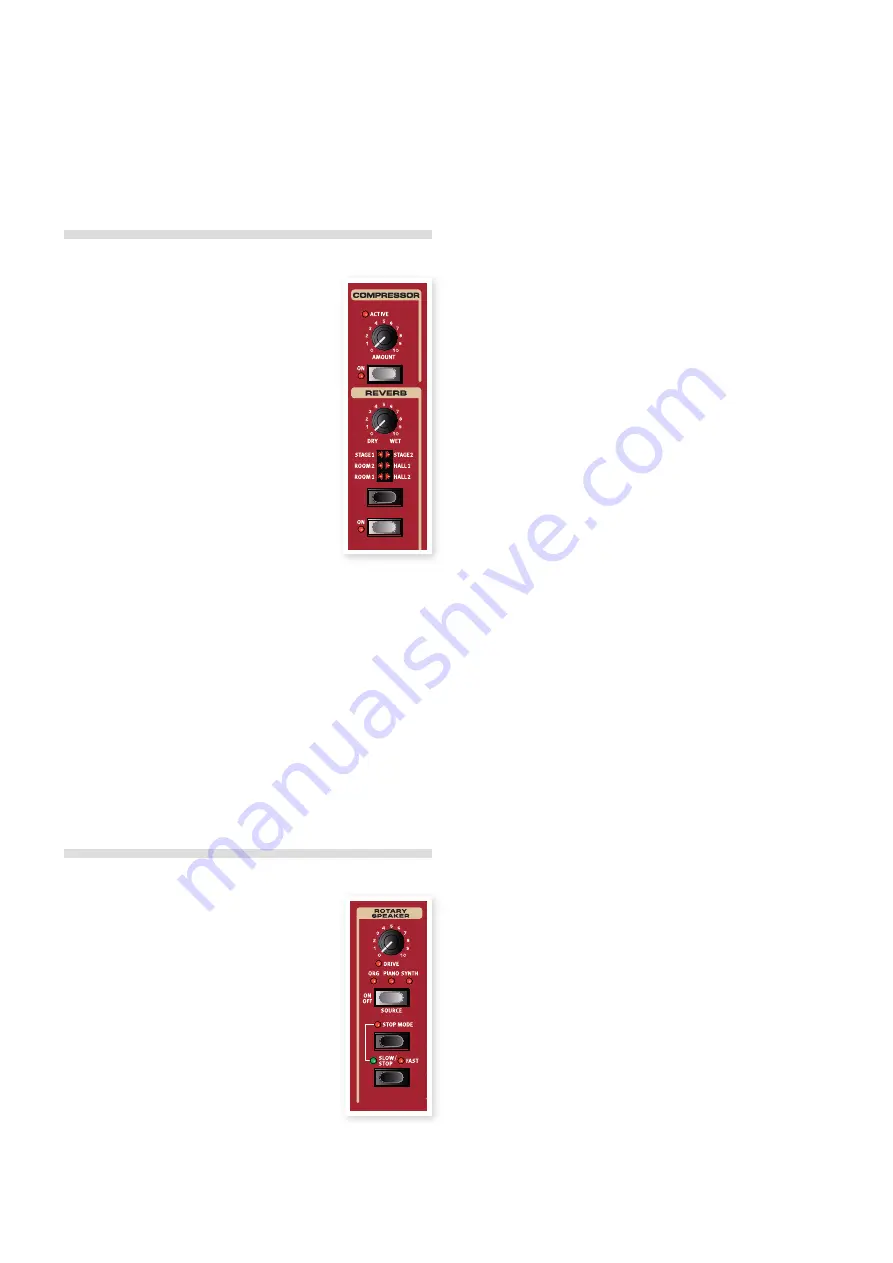
EQ section
This is a 3-band equalizer which features bass, sweep-able midrange
and treble controls . The bass frequency is 100 Hz, the treble frequency
is 4 kHz and the mid range frequency can be set between 200 Hz to 8
kHz . The boost/cut range is +/- 15 dB .
Global Effects
If activated, the Compressor and Reverb effects will
process all signals routed to the CH 1/CH 2 and
headphone outputs, but do not affect any signals
routed to the CH 3/CH 4 outputs . Both these ef-
fects are stereo in/stereo out .
Compressor
The Compressor will even out the dynamics of what
you play, making low level sounds louder and high
level sounds more quiet . This produces a tight,
punchy sound and makes the overall level easier
to control in a live mix situation . The Compressor
is activated with the On button . The Amount knob
controls the amount of compression applied .
Reverb
The Reverb section simulates the natural sound reflections in various
acoustic environments . There are six reverb types with various lengths
and densities, indicated by the LEDs in the selector .
The Hall reverbs have the response and character of a spacious hall,
with a fairly long decay . The Stage reverbs have a medium decay time
and the Rooms are more of an ambience with a rather short decay
time .
The “reverb 1” is a more mellow version, while the “2” is brighter .
The Dry/Wet knob sets the balance between the unprocessed and the
processed signal .
Rotary Speaker
The Rotary Speaker in Nord Stage 2 accurately
reproduces the sound of the rotating horn and bass
rotor, as well as the characteristics of the built-in
amplifier of the original rotary units . The Rotary ef-
fect is mono in/Stereo out .
• The Rotary effect is activated or de-activated for
a selected instrument in the same way as the Slot
Effects, by pressing the Source button .
• You switch between fast and slow rotor speeds
by pressing the Slow/Stop button .
• To stop the rotors, press the Stop Mode button to
activate the Stop Mode and then the Slow/Stop
button (this does not deactivate the Rotary Speaker - it only stops
the rotors) . When you press the Slow/Stop button again the rotors
will accelerate to the Fast speed setting . This functionality mimics the
behavior of an early, one speed rotary speaker .
• The rotor acceleration rate, the time it takes to go from slow to fast
and vice versa, can be adjusted on the Sound menu, read more on
page 43 .
• The Rotary speed can be continuously controlled with a Morph
source . This makes it possible to set the rotary at speeds other than
just fast, slow and stopped .
The Drive knob controls the amount of overdrive . This simulates the
pre-amplifier overdrive of the original rotary speakers .
A sustain pedal or a foot switch that is connected to the Rotor Speed
pedal input can control the rotor speed, read more on page 55 .
About the Rotary effect’s signal routing
The Rotary effect is placed after the panel effects in Nord Stage 2’s
signal path . It also sums audio signals if both Slot A and B are active .
This means that if you are using a split organ setup for example, both
“manuals” will be affected by the Rotary effect (just like on the real
thing) .
M
The Rotary Drive parameter is dependent on the processed
instrument’s Level setting. If the instrument being processed by
the Rotary is set to a very low level, the amount of available drive
will be significantly reduced. Again, this is very much like it works
with the “real articles” - when you increase the organ level, e.g.
by using a swell pedal, the amount of distortion from the Rotary
effect increases.
Rotary parameter
There is a parameter in the Sound Menu that sets the acceleration and
deceleration rate of the rotary speakers . Read more about on this on
page 43 .
Chapter9effeCtS | 39






























